Appendix:
List of Kabuki Actors
The following is an alphabetical list of major actors. It is not a complete list, and I apologize to the many fine lower ranking actors whom I have left out. Included are the actors' yago, or acting-house names, and family relationship where I consider them to be important. Actors may change their names in the course of their careers, but this list is accurate at the time of publication.
| Actor's name | Born | Yago | Family relationship |
Bando |
Hikosaburo VIII | 1943 | Otowa-ya | First son of Uzaemon XVII |
Mitsuguro IX | 1929 | Yamato-ya |
Shonosuke I | 1954 | Otowa-ya | Third son of Uzaemon XVII |
Tamasaburo V | 1950 | Yamato-ya | Adopted son of Morita |
| Kanya XIV (d. 1975) |
Yajuro I | 1956 |
Yasosuke V | 1956 | Son or Mitsugoro IX |
Ichikawa |
Danjuro XII | 1946 | Narita-ya | Son of Danjuro IX (d. 1965) |
Danshiro IV | 1946 | Omodaka-ya | Younger brother of |
| Ennosuke III |
Danzo IX | 1951 | Mikawa-ya |
Ennosuke III | 1939 | Omodaka-ya | Elder brother of Danshiro IV |
Kamejiro II | 1975 | Son of Danshiro IV |
Komazo XI | 1957 | Korai-ya |
Monnosuke VIII | 1959 | Takino-ya |
Otora III | 1967 | Son of Sadanji IV |
Sadanji IV | 1940 | Takashima-ya |
Shinnosuke VII | 1977 | Narita-ya | Son of Danjuro XII |
Somegoro VII | 1973 | Korai-ya | Son of Matsumoto Koshiro IX |
Ichimura |
Manjiro II | 1949 | Tachibana-ya | Second son of Uzaemon XVII |
Uzaemon XVII | 1916 |
Iwai |
Hanshiro X | 1927 | Yamato-ya |
Kataoka |
Gato V | 1935 | Matsushima-ya | First son of Nizaemon XIII |
| (d. 1994) |
Hidetaro II | 1941 | Second son of Nizaemon XIII |
Nizaemon XV | 1944 | Third son of Nizaemon XII |
Roen VI | 1926 |
Takataro I | 1968 | Son of Nizaemon XV |
Kawarasaki |
Gonjuro III | 1918 | Yamazaki-va |
Matsumoto |
Koshiro IX | 1939 | Korai-ya | Elder brother of Kichiemon II |
Nakamura |
Baigyoku IV | 1946 | iakasago-ya | Adopted son of Utaemon VI |
Fukusuke IX | 1960 | Nankoma-ya | First son of Shikan VII |
Ganjiro III | 1936 |
Hashinosuke III | 1965 | Second son of shikan VII |
Jakuemon IV | 1920 | Kyo-ya |
Kanjaku V | 1959 | Narikoma-ya | First son of Ganjiro III |
Kankuro V | 1955 | Nakamura-ya | Son of Kanzaburo XVII |
| (d. 1988) |
Kantaro II | 1981 | First son of Kankuro V |
Karoku V | 1950 | Yorozu-ya | Elder brother of Kasho III |
Kasho III | 1956 | Younger brother of Karoku V |
Kichiemon II | 1944 | Harima-ya | Younger brother of Koshiro IX |
Matagoro II | 1914 |
Matsue V | 1948 | Kaga-ya | Adopted son of Utaemon VI |
Senjaku III | 1960 | Narikoma-ya | Second son of Ganjiro III |
Shibajaku VII | 1955 | Kyo-ya | Second son of Jakuemon IV |
Shichinosuke 11 | 1983 | Nakamura-ya | Second son of Kankuro V |
Shinjiro I | 1959 | Yorozu-ya | Younger brother of Tokizo V |
Shikan VII | 1928 | Nankoma-ya | Nephew of Utaemon VI |
lokizo V | 1955 | Yorozu-ya | Elder brother of Shinjiro I |
Tomijuro V | 1929 | Tennoji-ya |
Tozo VI | 1938 | Kaga-ya |
Utaemon VI | 1917 | Nankoma-ya |
Onoe |
Kikugoro VII | 1942 | Otowa-ya | Son of Baiko VII (d. 1995) |
Kikuzo VI | 1923 | " |
Matsusuke VI | 1946 |
Tatsunnosuke II | 1975 | Son ofTatsunoke I (d.1987) |
Ushinosuke VI | 1977 | Son of Kikugoro VII |
Otani |
Tomoemon VIII | 1949 | Akashi-ya | First son of Jakuemon IV |
Sawamura |
Sojuro IX | 1933 | Kinokuni-ya | Elder brother of Tojuro II |
Tanosuke VI | 1932 |
Tojuro II | 1943 | Younger brother ot Sojuro IX |
CHAPTER
Kabuki 400 Years of History
 BEFORE THE seventeenth century, the principal forms of theater in Japan were the bugaku court dances, the aristocratic, refined Noh dramas with their accompanying Kyogen comedies, and the Ningyo Joruri, which developed into today's Bunraku puppet theater. The Noh drama had reached a state of perfection by the fourteenth century and was patronized by the daimyo (feudal lords) and the samurai upper classes. In Noh, the principal actors wear masks, and the dialogue, either chanted by the actors or by a small on-stage chorus, is accompanied by drums and a flute. Dance, which plays a major role in Noh, is slow and sedate, consisting of circular movements in which the feet rarely leave the floor except for an occasional rhythmic stamping. Props are kept to a minimum and the set is always the same: a pine tree painted on a plain wooden backdrop. The stage is small and characterized by a walkway extending from a greenroom to the main stage.
BEFORE THE seventeenth century, the principal forms of theater in Japan were the bugaku court dances, the aristocratic, refined Noh dramas with their accompanying Kyogen comedies, and the Ningyo Joruri, which developed into today's Bunraku puppet theater. The Noh drama had reached a state of perfection by the fourteenth century and was patronized by the daimyo (feudal lords) and the samurai upper classes. In Noh, the principal actors wear masks, and the dialogue, either chanted by the actors or by a small on-stage chorus, is accompanied by drums and a flute. Dance, which plays a major role in Noh, is slow and sedate, consisting of circular movements in which the feet rarely leave the floor except for an occasional rhythmic stamping. Props are kept to a minimum and the set is always the same: a pine tree painted on a plain wooden backdrop. The stage is small and characterized by a walkway extending from a greenroom to the main stage.
Puppets have been popular in Japan since the Heian period (794-1185), and the art of manipulating them has grown, together with developments in accompanying recitation and music. The three-stringed shamisen was introduced to Japan from China around 1560 and quickly rose in popularity. The chanted recitation accompanying the puppets was perfected by the great chanter Takemoto Gidayu (1651-1714), who founded a puppet theater in Osaka in 1685 and began a collaboration with Chikamatsu Monzaemon, widely regarded as Japan's greatest playwright.
The earliest reference to Kabuki dates to 1603 and a written record concerning a group of dancers led by a woman named Okuni. Okuni was probably a former shine maiden and possibly a prostitute. She and her group gave performances on a makeshift Noh stage set up on the dry bed of the Kamo River in Kyoto. Her dances, which did away with masks and were far livelier than anything seen in Noh, seem to have been an original mixture of folk dance and a type of religious dance called nenbutsu odori. They were supplemented with lewd skits concerning Nagoya Sanza (a famous samurai of the day), a courtesan or teahouse madam, and a clown. Okuni's dances and skits became extremely popular and the name Kabuki was applied to them, from the word kabuku, now archaic, which literally meant "titled" but implies that which is strange, exotic, and possibly somewhat risque.

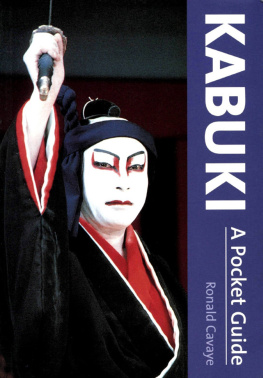






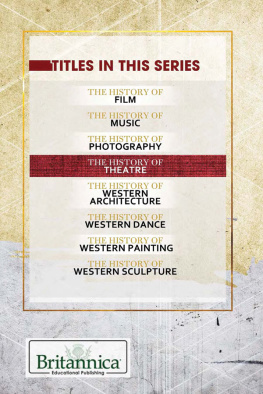
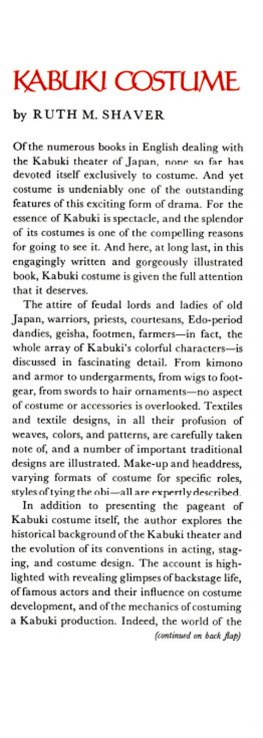

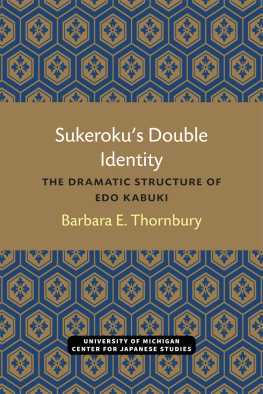
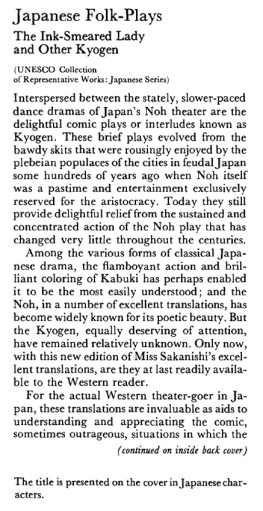


 BEFORE THE seventeenth century, the principal forms of theater in Japan were the bugaku court dances, the aristocratic, refined Noh dramas with their accompanying Kyogen comedies, and the Ningyo Joruri, which developed into today's Bunraku puppet theater. The Noh drama had reached a state of perfection by the fourteenth century and was patronized by the daimyo (feudal lords) and the samurai upper classes. In Noh, the principal actors wear masks, and the dialogue, either chanted by the actors or by a small on-stage chorus, is accompanied by drums and a flute. Dance, which plays a major role in Noh, is slow and sedate, consisting of circular movements in which the feet rarely leave the floor except for an occasional rhythmic stamping. Props are kept to a minimum and the set is always the same: a pine tree painted on a plain wooden backdrop. The stage is small and characterized by a walkway extending from a greenroom to the main stage.
BEFORE THE seventeenth century, the principal forms of theater in Japan were the bugaku court dances, the aristocratic, refined Noh dramas with their accompanying Kyogen comedies, and the Ningyo Joruri, which developed into today's Bunraku puppet theater. The Noh drama had reached a state of perfection by the fourteenth century and was patronized by the daimyo (feudal lords) and the samurai upper classes. In Noh, the principal actors wear masks, and the dialogue, either chanted by the actors or by a small on-stage chorus, is accompanied by drums and a flute. Dance, which plays a major role in Noh, is slow and sedate, consisting of circular movements in which the feet rarely leave the floor except for an occasional rhythmic stamping. Props are kept to a minimum and the set is always the same: a pine tree painted on a plain wooden backdrop. The stage is small and characterized by a walkway extending from a greenroom to the main stage.